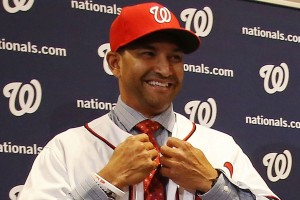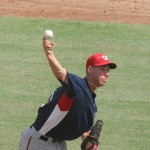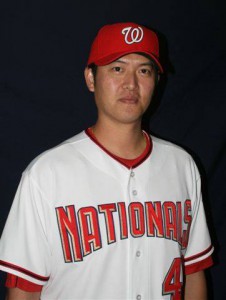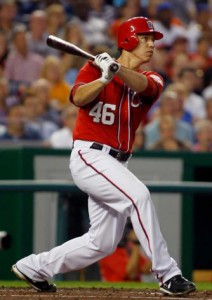“Its early.”
“Its only May.”
“Its a long season.”
Yeah.
The Nats woke up this morning (after a well deserved night’s sleep presumably after their interesting plane odyssey from Philadelphia sunday night) and find themselves seven games under .500. And their next 15 games, taking them completely through the month of May, are against Milwaukee (best team in the NL last year by record), Los Angeles Dodgers (2x defending NL champs), New York Mets (who have 3 arms who at any given time will shut down a team), and the Cubs (currently in 1st place in the Central and of course 4x straight playoff participants).
So, we probably shouldn’t be surprised when they go 5-10 or 6-9 between now and June 1. Lets give them the benefit of the doubt and they go 6-9; that’d put their record at 20-30 through their first 50 games.
That’s ridiculous.
Yes they’ve gotten hit with injuries. Tell that to the Yankees, who (as of this writing) have 12 guys on the IL yet are seven games ABOVE .500. They too have lost key hitters (they’ve yet to have Aaron Hicks take an AB this year, and have both their primary sluggers Giancarlo Stanton and Aaron Judge on the IL as we speak), yet they keep on cruising despite being in a division with Tampa AND last year’s 108-game winning Boston team.
So what’s the difference? Why is a team like NY able to weather this storm but the Nationals seem impotent? It isn’t payroll; while the Yankees have a higher payroll than the Nats, the delta is almost entirely made up by one awful contract to Jacoby Ellsbury, who hasn’t played a game for the team since late 2017.
Is it management? Both the Nats and the Yankees jettisoned experienced, veteran managers at the same time in Dusty Baker and Joe Giradi; both got replaced by rookie managers (Dave Martinez and Aaron Boone). Boone came straight to the Yankees dugout from the broadcast booth, having spent basically every day after his playing retirement in the ESPN broadcast booth. Boone did not have *one day* of professional managerial experience or even professional coaching experience before taking over the club. Meanwhile Martinez was Joe Maddon‘s bench coach for more than a decade, interviewed with half the league for managerial openings before the Nats picked him. What’s happened since?
- Boone inherited a 91 win team, won 100 games in his first season and they have a .600 winning pct this year
- Martinez inherited a 97 win team, guided them to an 82 win season in 2018 and they have a .400 winning pct this year.
I guess those 12 years as a bench coach weren’t nearly as valuable as broadcasting games and eating off of expense accounts that Boone did for a decade. Maybe we should hire J.P. Santangelo to be Martinez’ replacement when he gets fired in a few weeks time.
Is it ownership? If you’ve read a single word that Tom Boswell has written about the Nats managerial situation, you’ll have read these points:
- Mike Rizzo and the “baseball people” absolutely did not want to get rid of Baker
- They were more or less bewildered by the choice of having to “find” someone to manage in 2018
- The owners, for reasons inexplicable, continue to view the on-field manager as a lowly mid-manager and not a well-paid, important position.
Is it roster construction? I personally thought that the off-season moves were fantastic. Gomes, Suzuki, Dozier, resigning Adams, signing Corbin, getting two closer-quality arms in Rosenthal and Barraclough. So what the heck is going on? Why can’t this team find 7 competent relievers to sit on the bench in RF awaiting a chance to “do no harm?”
Here’s the ERAs of the current 8 guys in the bullpen: 0.00 (Fedde), 1.15, 1.42, 6.75, 7.07, 3.55, 10.80, 16.88. So of course last night, when you needed someone to bail out the team after Strasburg‘s start fell apart in the 7th … you pick the f*cking guy with the 16.88 ERA! Why?? At what point do you look at the bullpen decisions of the manager and say to yourself, “enough is enough?”
This team, instead of dipping into any one of a dozen arms in AAA or AA who are pitching lights out, chose to give a contract to a re-tread who sat out the entirety of the spring training w/o a deal … and who now has retired just 8 of the 21 batters he’s faced. Why does he still have a job? How is it possible that this team missed so badly in their roster decisions w/r/t Trevor Gott (who currently has a sub 2.00 ERA for San Francisco) this spring? Was Gott really a lesser arm than Tanner Rainey, James Bourque, Austin Adams and Jimmy Cordero? Clearly he was, since the all four of these guys were kept instead of Gott.
Why is the team signing guys off the street instead of trying out Rainey, Bourque and Cordero? Why are they on the 40-man roster if you’re not going to use them? Go look up Bourque’s numbers in AA last year and this year; they’re phenomenal; why isn’t he getting called up? If your argument for not calling up Rainey and Cordero is, “they’re too wild in AAA” then, *why the hell are they on the roster?* If the answer is, “Oh well Rainey throws 100” well who frigging cares how hard you throw it if you can’t find the plate and thus can’t get called up and be trusted in MLB settings. Same with frigging Cordero; he was *awful* for the team last year, yet still occupies a roster spot, walking guys in AAA at nearly a guy an inning. Why?
DFA these guys, call up guys in the minors who ARE pitching well. There’s a slew of candidates at AAA (Derek Self, Dakota Bacus, Vidal Nuno has improved lately) who are pitching well. Same with AA (Mario Sanchez, Jacob Condra-Bogan, even Aaron Barrett are pitching great). I would have Included Adams here, with his ridiculous 21/3 K/BB ratio in AAA this year, but for reasons inexplicable the team opted to DFA him and trade him for a non-top 30 prospect and keep the unused Rainey/Bourque/Cordero crew instead of retaining him and seeing if his stuff would play this year in the majors. He got one inning of work this year; unlike Trevor Rosenthal he was actually able to COMPLETE said inning despite walking a couple of guys. You mean to tell me that was any worse than what Jennings could give us?
And then there’s the bats. Here’s our current non-catcher bench: Sanchez, Noll, Stevenson. Wow; do these guys have 5 career homers between them?? Way to really pack the bench with slap hitters for those crucial late-inning PH opportunities. Meanwhile Fresno has three veteran guys who are hitting the cover off the ball in Brandon Snyder (Westfields HS grad!), Jacob Wilson and Yadiel Hernandez. Any of them getting a sniff? Of course not. Because the team has to keep around guys like Kyle McGowin as an 8th starter (current AAA ERA: 5.00 in 7 starts) and a catcher they’ll probably never use in Raudy Read. Why?? Are you *trying* to win games? Why is Jake Noll taking pinch hitting duties at the major league level??
I dunno. Something needs to change. I just don’t get the way this team is being managed right now, both on and off the field.
/rant off.




